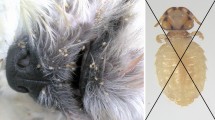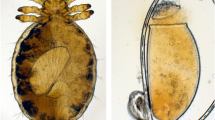Abstract
Lice infestations in horses caused by the chewing louse Werneckiella (Damalinia) equi are observed worldwide. In the present study, the efficacy of 10% imidacloprid was tested on horses naturally infested with lice. Two groups of animals received a double application of 4 ml and 8 ml Advantage 10% spot-on on day 0 and 28 either. Horses, presenting dermatological signs with negative lice counts, were also included in this investigation. 40.86% of the horses presented positive lice counts and 84.21% of these animals showed clinical dermatologic signs. 65.45% of the lice-negative horses also showed clinical manifestations. Two days after treatment, lice counts dropped in both the treatment groups and on day 56, all animals were free of alive lice, and dermatological lesions decreased significantly (P<0.001) in both the lice-positive and the negative animals. No correlation (P>0.050) between lice burden and clinical signs was detected.
Similar content being viewed by others
References
Foil I, Foil C (1986) Parisitic Skin Disease. In: Vet Clin North Am: Equine Prac Vol 2(2):420–421
Hanssen I, Mencke N, Asskildt H, Ewald-Hamm D, Dorn H (1999) Field study on the insecticidal efficacy of Advantage against natural infestations of dogs with lice. Parasitol Res 85:347–348
Hopkins TJ, Kerwick C, Gyr P, Woodley S (1996) Efficacy of imidacloprid to remove and prevent Ctenocephalides felis infestations on dogs and cats. Aust Vet Pract 26:150–153
Hutchinson MJ, Jacobs DE, Bell GD, Mencke N (2001a) Evaluation of imidacloprid for treatment and prevention of cat flea (Ctenocephalides felis felis) infestations on rabbits. Vet Rec 148:695–696
Hutchinson MJ, Jacobs DE, Mencke N (2001b) Establishment of the cat flea (Ctenocephalides felis felis) on the ferret (Mustela putorius furo) and its control with imidacloprid. Med Vet Entomol 15:212–214
James PJ (1999) Do sheep regulate the size of their mallophagan louse populations? Int J Parasitol 29:869–875
James PJ, Moon RD (1998) Pruritus and dermal response to insect antigens in sheep infested with Bovicola ovis. Int J Parasitol 28:419–427
Klein SL (2004) Hormonal and immunological mechanisms mediating sex differences in parasite infection. Parasite Immunol 26:247–264
Krämer F, Mencke N (2001) Flea biology and control. Springer, Berlin Heidelberg New York, pp 106–126
Larsen KS, Mencke N, Eydal M, Sigurðsson S (2005) Infestation of (Werneckiella equi) in Icelandic horses, characteristics of predilection sites and lice dermatitis. Parasitol Res (accepted) DOI 10.1007/s00436-005-1380-0
Mehlhorn H, D’Haese J, Mencke N, Hansen O (2001) In vivo and in vitro effects of imidacloprid on sheep keds (Melophagus ovinus): a light- and electron-microscopy study. Parasitol Res 87:331–336
Mencke N, Larsen KS, Eydal M, Sigurðsson S (2004) Natural infestation of the chewing lice (Werneckiella equi) in horses and treatment with imidacloprid and phoxim. Parasitol Res 94:367–370
Perris EE (1995) Louse infestations. In: Turner AS (ed) Dermatology. Vet Clinics of North America, Equine Practice 11:20–28
Reuter K, Pospischil R, Endepols S, Larsen KS, Mencke N (2002) Flea infestation in exotic pet animals. Suppl Comp Cont Educ Pract Vet 24(4B):10–13
Rommel M (ed) (2001) Veterinärmedizinische Parasitologie, 5th edn. Paul Parey Verlag, Singhofen pp 421–422
Rust MK, Dryden MW (1997) The biology, ecology and management of the cat flea. Annu Rev Entomol 42:451–473
Author information
Authors and Affiliations
Corresponding author
Rights and permissions
About this article
Cite this article
Mencke, N., Larsen, K.S., Eydal, M. et al. Dermatological and parasitological evaluation of infestations with chewing lice (Werneckiella equi) on horses and treatment using imidacloprid. Parasitol Res 97, 7–12 (2005). https://doi.org/10.1007/s00436-005-1379-6
Received:
Accepted:
Published:
Issue Date:
DOI: https://doi.org/10.1007/s00436-005-1379-6




